1994 OLDSMOBILE SILHOUETTE oil filter
[x] Cancel search: oil filterPage 195 of 276
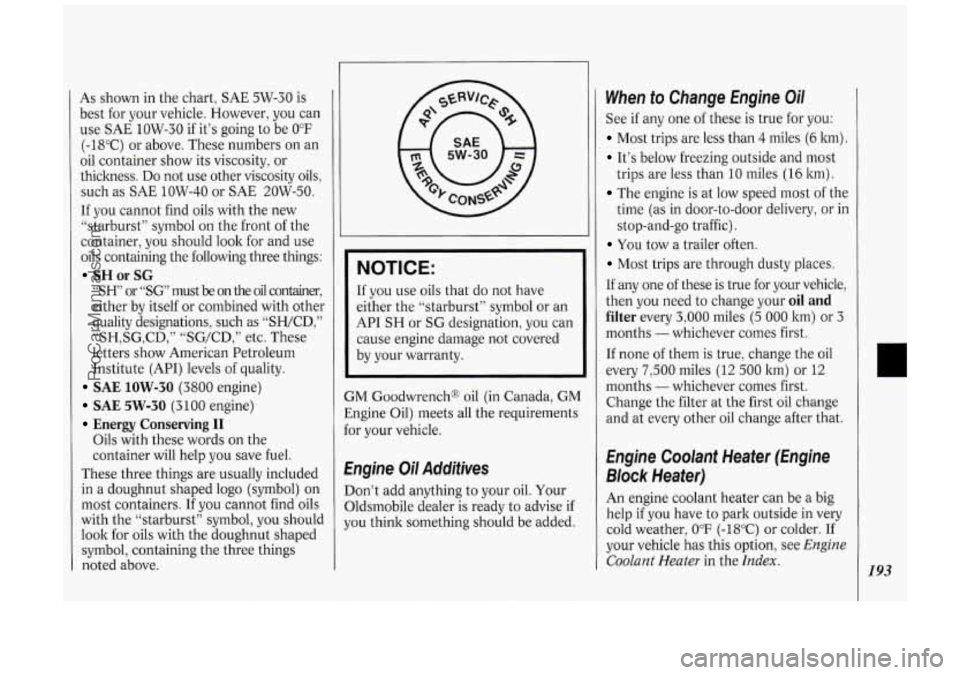
As shown in the chart, SAE 5W-30 is
best for your vehicle. However, you can
use SAE 1OW-30 if it’s going
to be 0°F
(-18°C) or above. These numbers on an
oil container show
its viscosity, or
thickness.
Do not use other viscosity oils,
such as SAE 1OW-40 or SAE 20W-50.
If you cannot find oils with the new
“starburst” symbol on the front of the
container, you should look for and use
oils containing the following three things:
SH or SG
“SH’ or “SG’ must be on the oil container,
either by itself or combined with other
quality designations, such as “SHKD,”
“SH,SG,CD,” “SG/CD,” etc. These
letters show American Petroleum
Institute (API) levels of quality.
SAE 1OW-30 (3800 engine)
SAE 5W-30 (3100 engine)
Energy Conserving I1
Oils with these words on the
container will help you save fuel.
These three things are usually included
in a doughnut shaped logo (symbol) on
most containers.
If you cannot find oils
with the “starburst” symbol,
you should
look for oils with the doughnut shaped
symbol, containing the three things
noted above. If
you use oils that do not have
either the “starburst” symbol or an
API SH or
SG designation, you can
cause engine damage not covered
by your warranty.
GM Goodwrench@ oil (in Canada, GM
Engine Oil) meets all the requirements
for your vehicle.
Engine Oil Additives
Don’t add anything to your oil. Your
Oldsmobile dealer is ready to advise if
you think something should be added.
When to Change Engine Oil
See if any one of these is true for you:
Most trips are less than 4 miles (6 ltm).
It’s below freezing outside and most
trips are less than
10 miles (16 ltm).
The engine is at low speed most of the
time
(as in door-to-door delivery, or in
stop-and-go traffic).
You tow a trailer often.
Most trips are through dusty places.
If any one of these is true for your vehicle,
then you need to change your
oil and
filter every 3,000 miles (5 000 ltm) or 3
months - whichever comes first.
If none
of them is true, change the oil
every
7,500 miles (12 500 ltm) or 12
months -whichever comes first.
Change the filter at the first oil change
and at every other oil change after that.
Engine Coolant Heater (Engine
Block Heater)
An engine coolant heater can be a big
help if you have to park outside in very
cold weather,
0°F (-18°C) or colder. If
your vehicle has this option, see
Engine
Coolant Heater in the Index. 193
ProCarManuals.com
Page 196 of 276
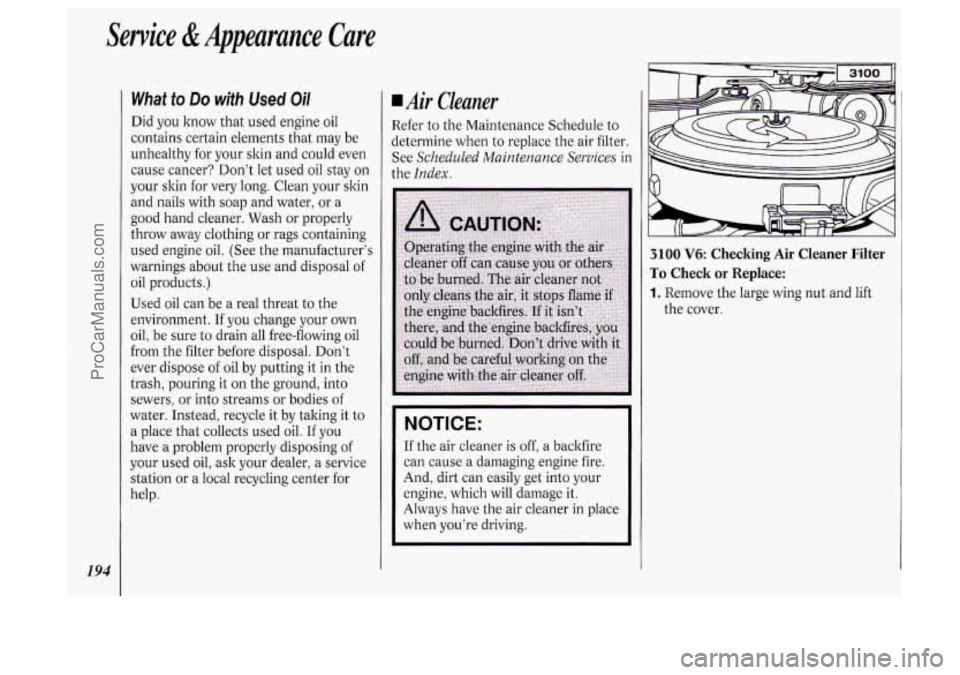
Service &Appearance Care
194
What to Do with Used Oil
Did you know that used engine oil
contains certain elements that may be
unhealthy for your skin and could even
cause cancer? Don’t let used oil stay on
your skin for very long. Clean your skin
and nails with soap and water, or a
good hand cleaner. Wash or properly
throw away clothing or rags containing
used engine oil. (See the manufacturer’s
warnings about the
use and disposal of
oil products.)
Used oil can be
a real threat to the
environment. If you change your own
oil, be sure to drain all free-flowing oil
from the filter before disposal. Don’t
ever dispose
of oil by putting it in the
trash, pouring it on the ground, into
sewers, or into streams or bodies
of
water. Instead, recycle it by taking it to
a place that collects used oil. If you
have a problem properly disposing
of
your used oil, ask your dealer, a service
station or a local recycling center for
help.
Air Cleaner
Refer to the Maintenance Schedule to
determine when to replace the air filter.
See
Scheduled Maintenance Services in
the Index.
NOTICE:
If the air cleaner is off, a backfire
can cause
a damaging engine fire.
And, dirt can easily get into your
engine, which will damage it.
Always have the air cleaner in place
when you’re driving.
ProCarManuals.com
Page 197 of 276
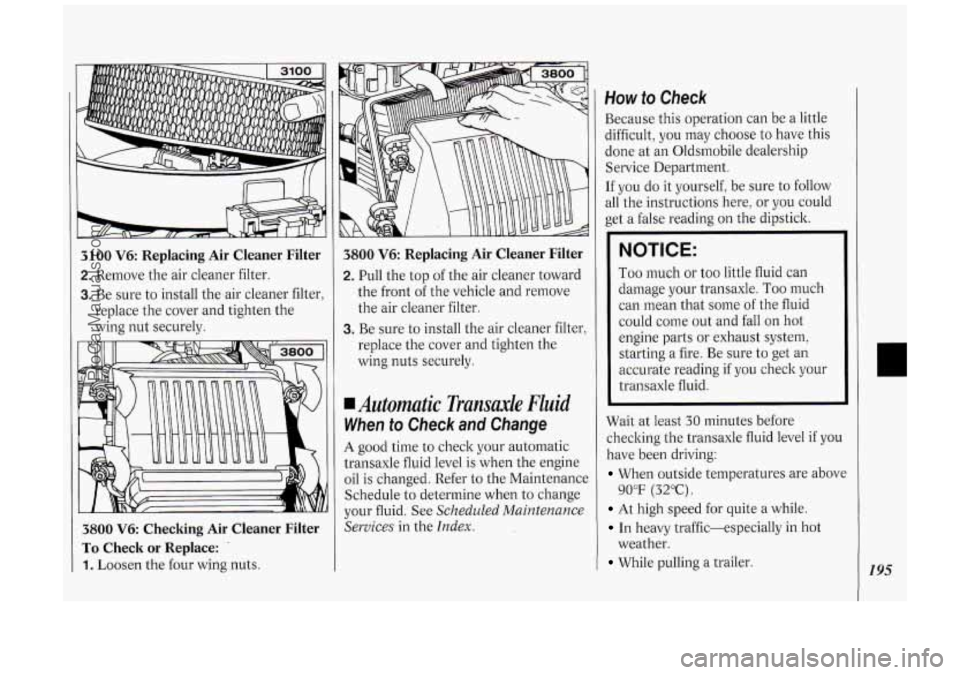
3100 V6: Replacing Air Cleaner Filter
2. Remove the air cleaner filter.
3. Be sure to install the air cleaner filter,
replace the cover and tighten the
wing nut securely.
3800 V6 Checking Air Cleaner Filter
To Check or Replace: .
1. Loosen the four wing nuts.
3800 V6: Replacing Air Cleaner Filter
2. Pull the top of the air cleaner toward
the front of the vehicle and remove
the air cleaner filter.
3. Be sure to install the air cleaner filter,
replace the cover and tighten the
wing nuts securely.
Automatic Transaxle Fluid
When to Check and Change
A good time to check your automatic
transaxle fluid level is when the engine
oil is changed. Refer
to the Maintenance
Schedule to determine when to change
your fluid. See
Scheduled Maintenance
Services
in the Index.
How to Check
Because this operation can be a little
difficult, you may choose to have this
done at an Oldsmobile dealership
Service Department.
If you do it yourself, be sure to follow
all the instructions here, or you could
get a false reading on the dipstick.
NOTICE:
Too much or too little fluid can
damage your transaxle.
Too much
can mean that some of the fluid
could come out and fall on hot
engine parts or exhaust system,
starting a fire. Be sure to get an
accurate reading if you check your
transaxle fluid.
Wait at least
30 minutes before
checking the transaxle fluid level
if you
have been driving:
When outside temperatures are above
At high speed for quite a while.
In heavy traffic-especially in hot
While pulling a trailer.
90°F (32°C).
weather.
195
ProCarManuals.com
Page 226 of 276
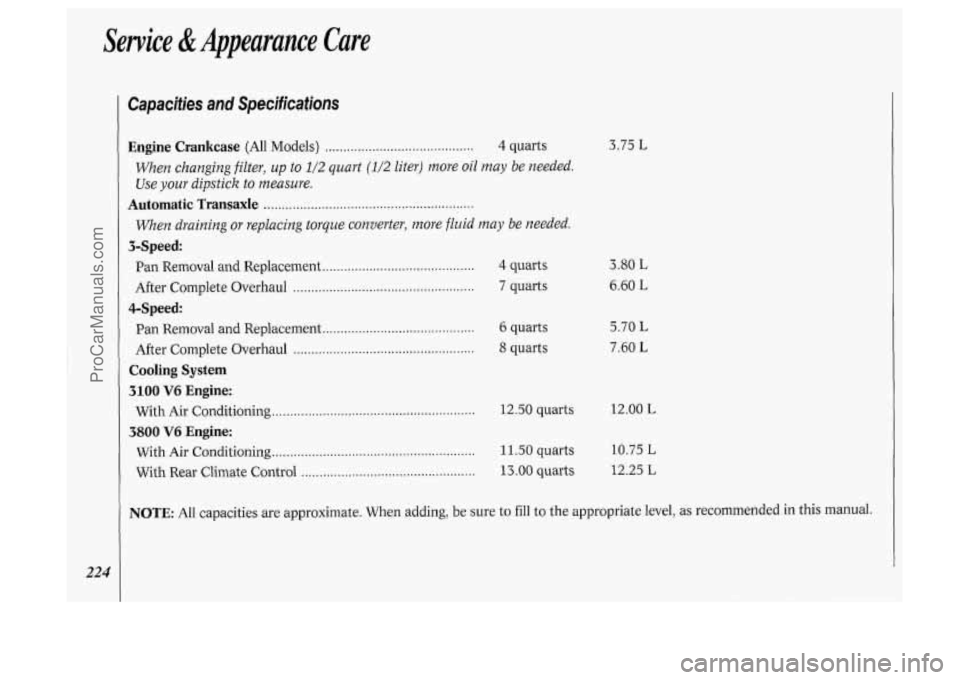
Service & Appearance Care
224
Capacities and Specifications
Engine Crankcase (All Models) ......................................... 4 quarts
When changing filter, up to 112 quart (1/2 liter) more oil may be needed.
Use
your dipstick to measure.
Automatic Transaxle ..........................................................
When draining or replacing torque converter, more fluid may be needed.
Pan Removal and Replacement .......................................... 4 quarts
After Complete Overhaul
.................................................. 7 quarts
3-Speed:
4-Speed:
Pan Removal and Replacement .......................................... 6 quarts
After Complete Overhaul
.................................................. 8 quarts
Cooling System
3100 V6 Engine:
3800 V6 Engine:
With Air Conditioning ........................................................ 12.50 quarts
With Air Conditioning ........................................................ 11.50 quarts
With Rear Climate Control
................................................ 13 .OO quarts
3.75 L
3.80 L
6.60 L
5.70 L
7.60 L
12.00 L
10.75
L
12.25 L
NOTE: All capacities are approximate. When adding, be sure to fill to the appropriate level, as recommended in this manual.
ProCarManuals.com
Page 228 of 276

226
Service & Appearance Care
Engine Specifications
VIN Engine Code ...........................................
Type ................................................................
Displacement ..................................................
Compression Ratio .......... ....... .. .. .. ..... .............
Firing Order ...................... .. ....................... ... ..
Thermostat Temperature Specification . . . . . . . . .
31 00 V6 Engine
D
V6
3.1 Liters
8.5:1
1-2-3-4-5-6
195°F (91°C)
3800 V6 Engine
1
V6
3.8 Liters
9.0:
1
1-6-5-4-3-2
195°F (91°C)
Normal Maintenance Replacement Parts
Air Cleaner Element ....................................... AC Type A-773C AC Type A-974C
Engine
Oil Filter ............................................. AC Type PF-51 AC Type PF-47
PCV Valve
................. .. ................... .... ... . . . ...... AC Type CV-789C AC Type CV-892C
Spark Plugs
...... . , . . . . . . . . . . . . .. . . . . . . .. . . . . . . , . . . . . . . . . . . . . . . . AC Type oR43TS AC Type 41-600
Remote Lock Control Batteries (2)
............... DL 2016 DL 2016
Gap: 0.045
inch (1.14
mm) Gap: 0.060 inch (1.52 mm)
ProCarManuals.com
Page 236 of 276
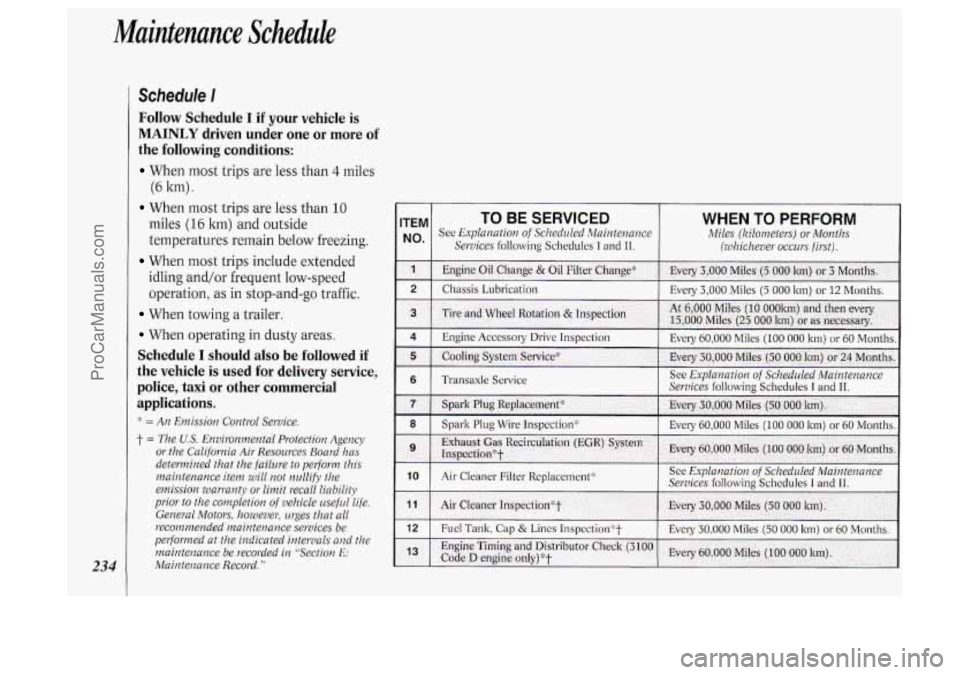
Muintenunce Schedule
234
Schedule I
Follow Schedule I if your vehicle is
MAINLY driven under one or more of
the following conditions:
When most trips are less than 4 miles
When most trips are less than 10
(6
ltm)
.
miles (16 ltrn) and outside
temperatures remain below freezing.
When most trips include extended
idling and/or frequent low-speed
operation, as in stop-and-go traffic.
When towing a trailer.
When operating in dusty areas.
Schedule I should also be followed if
the vehicle is used for delivery service,
police, taxi
or other commercial
applications.
::: = An Emission Control Service.
j- = The U.S. Emiyonmental Protection Agency
or the California Air Resources Board has
determined that the failure
to pelform this
maintenance item will
not nullify the
emission warranty or limit recall liability
prior
to the completion of vehicle useful life.
General Motors, however, urges that all
recommended maintenance services be
pelformed at the indicated intervals and the
maintenance be recorded in “Section
E:
Maintenance Record.”
ITEM TO BE SERVICED WHEN TO PERFORM
No* See Explanation of Scheduled Maintenance Miles (Kilometers) or Months
Services
following Schedules I and 11. (whichever occurs firsl).
1 Engine Oil Change & Oil Filter Change* Every 3,000 Miles (5 000 km) or 3 Montl~s..
2 Chassis Lubrication Every 3,000 Miles (5 000 lm) or 12 Months.
ProCarManuals.com
Page 240 of 276
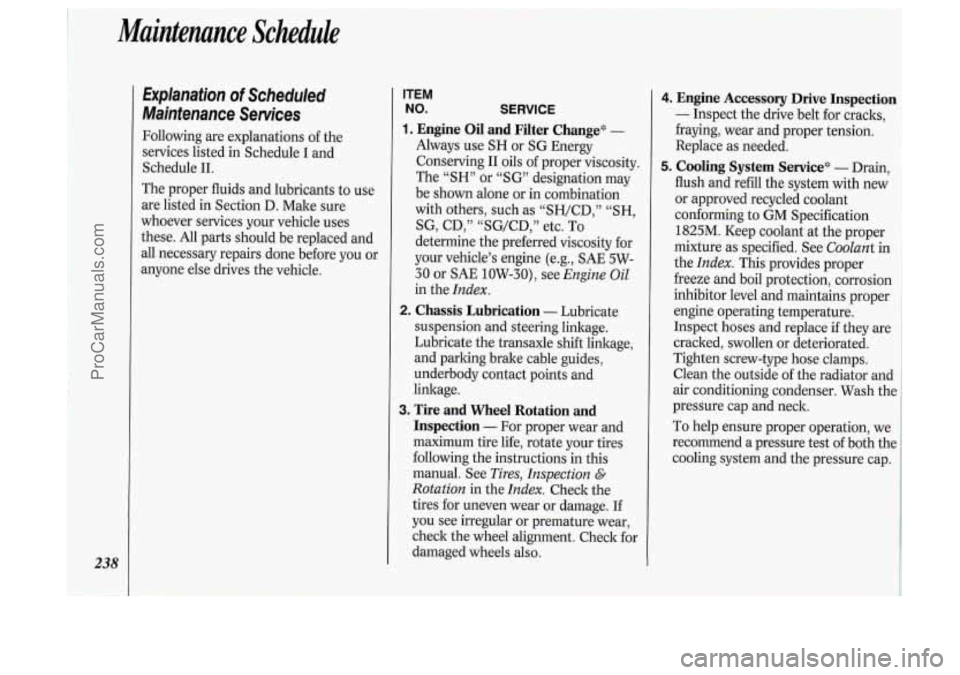
Maintenance Schedule
238
Explanation of Scheduled
Maintenance Services
Following are explanations of the
services listed in Schedule I and
Schedule 11.
The proper fluids and lubricants to use
are listed in Section D. Make sure
whoever services your vehicle uses
these. All parts should be replaced and
all necessary repairs done before you or
anyone else drives the vehicle.
ITEM
NO. SERVICE
1. Engine Oil and Filter Change* -
Always use SH or SG Energy
Conserving
I1 oils of proper viscosity.
The
“SH” or “SG” designation may
be shown alone
or in combination
with others, such as “SH/CD,”
“SH,
SG, CD,” “SG/CD,” etc. To
determine the preferred viscosity for
your vehicle’s engine (e.g.,
SAE 5W-
30 or SAE 10W-30), see
Engine Oil
in the Index.
2. Chassis Lubrication - Lubricate
suspension and steering linkage.
Lubricate the transaxle shift linkage,
and parking brake cable guides,
underbody contact points and
linkage.
3. Tire and Wheel Rotation and
Inspection
- For proper wear and
maximum tire life, rotate your tires
following the instructions in this
manual. See
Tires, Inspection E.
Rotation in the Index. Check the
tires for uneven wear
or damage. If
you see irregular or premature wear,
check the wheel alignment. Check for
damaged wheels also.
Engine Accessory Drive Inspection
- Inspect the drive belt for cracks,
fraying, wear and proper tension.
Replace as needed.
I
Cooling System Servicee - Drain,
flush and refill the system with new
or approved recycled coolant
conforming to GM Specification
I
1825M. Keep coolant at the proper 1
mixture as specified. See Coolant in
the
Index. This provides proper
freeze and boil protection, corrosion
I
inhibitor level and maintains proper ’
engine operating temperature.
Inspect hoses
and replace if they are
cracked, swollen or deteriorated.
Tighten screw-type hose clamps.
Clean the outside of the radiator and
air conditioning condenser. Wash tht
pressure cap and neck.
To help ensure proper operation, we
recommend
a pressure test of both the
cooling system and the pressure cap.
ProCarManuals.com
Page 241 of 276

6. Transaxle Service - Change both
the fluid and filter every
15,000 miles
(25 000 ltm) if the vehicle is mainly
driven under one or more of these
conditions:
In heavy city traffic where the
outside temperature regularly
reaches
90°F (32°C) or higher.
In hilly or mountainous terrain.
When doing frequent trailer towing.
Uses such as found in taxi, police
car or delivery service.
If you do not use your vehicle under
any of these conditions, change both
the
fluid and filter every 100,000 miles
(166 000 ltm) .
7. Spark Plug Replacement::' -
Replace spark plugs with the proper
type. See
Replacement Parts in the
Index.
8. Spark Plug Wire Inspection''-
Inspect for burns, cracks or other
damage. Check the boot fit at the
distributor or coils and at the spark
plugs. Replace wires
as needed.
9. Exhaust Gas Recirculation (EGR)
System 1nspection':t
- Conduct
the
EGR system service as described
in the service manual.
To purchase a
service manual, see
Service
Publications
in the Index.
IO. Air Cleaner Filter Replacement+-
Replace every 30,000 miles
(50 000 ltm) or more often under
dusty conditions.
Ask your dealer
for the proper replacement intervals
for your driving conditions.
11. Air Cleaner Inspection''? - Inspect
all hoses and ducts for proper
hookup. Make sure the valve works
properly.
1nspection';:t - Inspect fuel tank,
cap and lines for damage
or leaks.
Inspect fuel cap gasket for an even
filler neck imprint or any damage.
Replace parts as needed. Periodic
replacement of the fuel filter
is not
required.
12. Fuel Tank, Cap and Lines
13. Engine Timing and Distributor
Check
(3100 Code D engine
only)'xt
- Adjust the timing to the
underhood label specifications.
Inspect the inside and outside
of the
distributor cap and rotor for cracks,
carbon tracking and corrosion.
Clean or replace as needed.
NOTE: To determine your engine's
displacement and code, see
Engine
Identification
in the Index.
': = An Enzission Control Service.
t = The U.S. Environmental Protection Agency
or the California Air Resources Boa1.d has
determined that the failure
to pelform this
maintenance item will
not nullify the
emission warranty
or limit recall liability
prior
to fhe completion of ~~ehicle useful life.
General
Motors: however, urges that all
recornmended maintenance services be
performed at the indicated intervals and the
maintenance be recorded
in "Section E:
Maintenance Record."
239
ProCarManuals.com